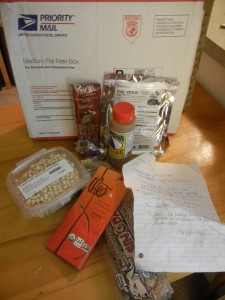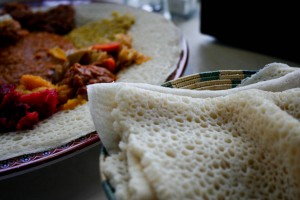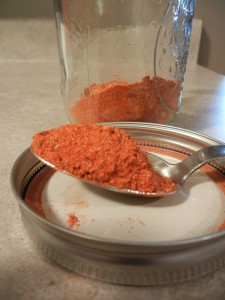
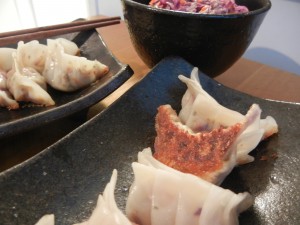
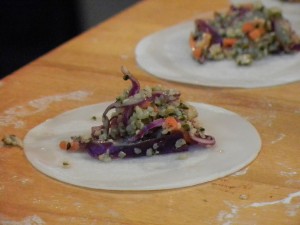
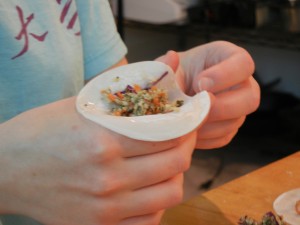
First of all, potstickers are one of my favorite things to eat. Pretty much any kind of dumpling is. But these are a particularly awesome thing to have on hand because they go from freezer to plate in under 10 minutes if you’ve already filled your freezer with them.
You can make a bunch at once by having a potsticker party on the weekend or whenever you have time. If you have leftover filling, it also makes great fried rice. Once you have the dumplings made, they can either be steamed or panfried/steamed.
This version of filling uses hempseeds as the main protein.
Ingredients
2 green onions, chopped
2 teaspoons grated fresh ginger
1 tablespoon chopped cilantro leaves (unless they taste like soap to you)
1 tablespoon soy sauce
1 tablespoon hoisin sauce (be sure to get vegan or make your own)
1 tablespoon sesame oil
1/4 teaspoon ground black pepper
8 oz. hempseeds
1 cup grated carrot
1 cup shredded cabbage (I used red because it was in season and pretty)
a large package of dumpling wrappers–40-50 or so
cornstarch
Mix all the liquids and seasonings in a large bowl. Add the hemp seeds. Now is a good time to grate the carrots and cabbage if you haven’t already. Add those to the bowl and mix. Get a small bowl of water to use while folding the dumplings–it helps the edges seal. You may also want a kitchen towel handy to keep your hands free of filling bits.
You’re now ready to begin folding dumplings. I intend to post a tutorial video about this later. Place about a teaspoon of filling on each wrapper. Add a streak of water all the way around the wrapper. Hold the dumpling in one hand like a taco and make sure the filling is compacted with your index finger. Pleat the edges of the wrapper together to seal the dumpling and then press the dumpling down on the table. Somewhere along the line, I learned that these dumplings are supposed to look like silver ingots. I’ve also seen dumplings in other shapes that are called silver ingot dumplings so I don’t know if that’s exactly right. Anyway, line up your silver ingots on a tray that will fit in your freezer and put a light layer of cornstarch on it to prevent them from sticking. Once you’re done, freeze them on the tray and when they are frozen, you can bag them up.
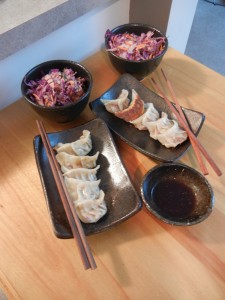
Preparation: Potsticker Style
This is how to turn your frozen dumplings (jiaozi) into potstickers. Also known as guotie, yaki gyoza, or mandu.
Heat oil of your choice in wok or shallow pan with a tight-fitting lid. If you have one with a glass lid, that’s probably going to be your best bet. On my stove, I set it at 6/10. Once the oil is hot, add the frozen dumplings. It’s ok to nestle them close together. Cover with the lid and cook 3 minutes. Get about 1/3 cup of water ready and quickly open the lid and pour it in. Immediately close the lid. Let cook 5-6 minutes or until water is mostly absorbed/evaporated. Remove lid and let cook and additional 2 minutes, or until all the water is gone. Remove from pan and serve. The final two minutes is enough time to whip up some sauce that goes very well with your hot potstickers. Mix equal parts soy sauce and rice vinegar (or to taste). Season with grated fresh ginger and sriracha to taste. Dip the dumplings into the sauce. It can even be used to help cool down hot dumplings so you can eat them sooner.
Preparation: Steam Style
This is how you turn your frozen dumplings into steamed dumplings (zhengjiao).
Use your favorite steaming method to cook the dumplings 10-12 minutes over medium heat. I have a bamboo steamer that just fits over a large pot. For this method, begin by bringing about half a pot of water to a boil. Lightly grease the steamer and fill with dumplings so that they do not touch. When the water is boiling, replace the lid with the bamboo steamer. Let steam 10-12 minutes and remove to plate. Dumplings will be slightly translucent. They are also good with the sauce mentioned above.

